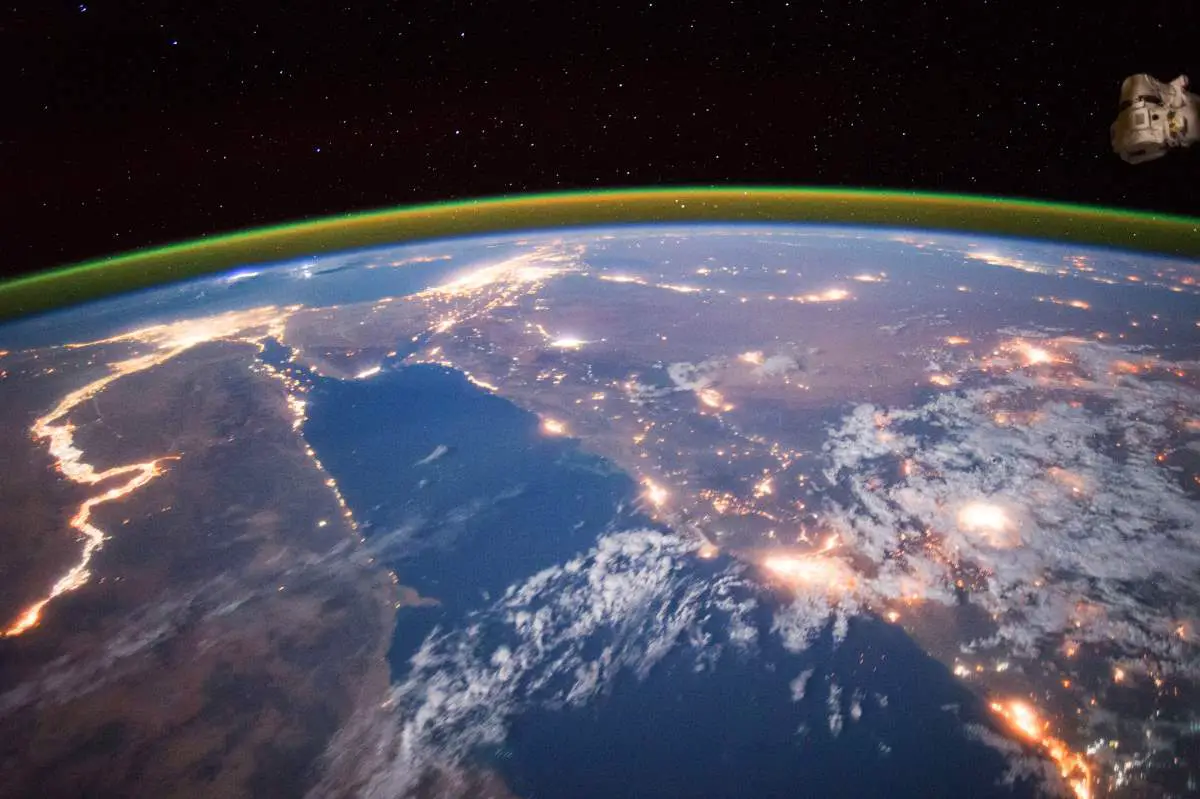Even we could remove the effects of the moonlight, starlight and diffused sunlight from the far side, the Earth’s night sky would never be totally dark. This phenomenon is known as Airglow (also called nightglow). Airglow is a faint emission of light by Earth’s atmosphere (or any planetary atmosphere).
The Earth’s Airglow
The Earth’s airglow phenomenon was first identified in 1868 by Swedish physicist and one of the founders of the science of spectroscopy, Anders Ångström (13 August 1814 – 21 June 1874). Since then, it has been studied in laboratories and even monitored by the SwissCube-1 probe (see notes 1).
Even though “airglow” is one of the factors limiting the reach of even the giant terrestrial telescopes (see notes 2), it is not easy to see it. It’s about one-tenth as bright as the combined light of all the stars in the sky. With cameras, you can photograph it only on the darkest of nights – and away from the areas with light pollution, of course.
But, from above, Earth’s airglow forms a luminous bubble encapsulating the planet – in the colors of red, green, purple, and yellow. Appearing right at the boundary between Earth and space, airglow holds clues to how our atmosphere affects weather in space and how space weather affects humans on Earth.
The bands of light span 50 to 400 miles (80-645 km) above Earth’s surface, through a

Airglow occurs when atoms and molecules in the upper atmosphere, excited by sunlight, emit light to shed their excess energy. Or, it can happen when atoms and molecules that have been ionized by sunlight collide with and capture a free electron. In both cases, they eject a particle of light – called a photon – in order to relax again. The phenomenon is similar to auroras, but where auroras are driven by high-energy particles originating from the solar wind, airglow is energized by ordinary, day-to-day solar radiation.
Unlike auroras, which are episodic and fleeting, airglow constantly shines throughout Earth’s atmosphere.
What makes the ionosphere complicated is that it’s constantly changing. It is cooked by extreme ultraviolet radiation from the Sun until molecules break apart, giving rise to a mix of charged ions and electrons. It’s neither fully Earth nor fully space. The ionosphere reacts both to winds and weather from the lower atmosphere below and solar energy streaming in from above, changing constantly to form conditions the scientists call space weather.
Space weather can affect astronauts, satellites, and much of the communications signals modern society relies upon. Scientists want to understand these changes, so they can eventually better predict them.

Airglow turns out to be a fantastic proxy not only for how particles move through the ionosphere but also what kinds of particles even exist there – key information for helping us tease out how space and Earth’s weather interconnect. Turbulence in this ever-changing sea of charged particles can manifest as disruptions that interfere with orbiting satellites or communication and navigation signals used to guide airplanes, ships, and self-driving cars.
Airglow carries information on the upper atmosphere‘s temperature, density, and composition, but it also helps us trace how particles move through the region itself. Vast, high-altitude winds sweep through the ionosphere, pushing its contents around the globe – and airglow’s subtle dance follows their lead, highlighting global patterns.
And that’s a great reason for NASA to study this beautiful phenomenon.

As shown in this image of Paranal Observatory, the skies regularly display a myriad of colors and astronomical sights, from the plane of the Milky Way shining brightly overhead to the orange-hued speck of Mars (left), the starry constellations of Scorpius and Orion, and the magenta splash of the Carina Nebula (upper middle). Despite the remote location, there are also occasional signs of human activity, for example, the sequence of lamps seen in the center of the frame. These faint lights illuminate the route from the Very Large Telescope (VLT) to the Visible and Infrared Survey Telescope for Astronomy (VISTA) where this image was taken. Due to the highly sensitive camera, this photograph also showcases a mysterious phenomenon called airglow. The night sky is ablaze with deep red and eerie green hues, caused by the faint glow of Earth’s atmosphere. Because of airglow, no observatory site on Earth could ever be absolutely, completely dark – although ESO’s do come pretty close.
This image was taken by talented astronomer and photographer Yuri Beletsky, a member of the 2016 ESO Fulldome Expedition team. This team visited Chile to gather spectacular images for use in the ESO Supernova Planetarium & Visitor Centre.
Credit: Y. Beletsky (LCO)/ESO
Photo and text: European Southern Observatory
Notes
- Launched on 23 September 2009, the SwissCube-1 is a Swiss satellite, a single unit CubeSat, which was designed to conduct research into nightglow within the Earth’s atmosphere and to develop technology for future spacecraft. It has also been used for amateur radio. It was the first Swiss satellite to be launched.
- Partly for this reason, space telescopes like Hubble can observe much fainter objects than current ground-based telescopes at visible wavelengths.
Sources
- Airglow on Wikipedia
- “Why NASA Watches Airglow, the Colors of the (Upper Atmospheric) Wind” on NASA.gov
- Airglow, Shining the Earth’s Atmosphere (in the Czech language) on Science World website
- SwissCube-1 on Wikipedia
- Budget of NASA, Year by Year [1980-1989] - June 10, 2024
- Budget of NASA, Year by Year [1970-1979] - June 10, 2024
- Budget of NASA, Year by Year [1958-2024] - June 10, 2024
